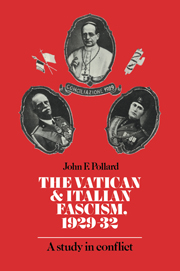Book contents
- Frontmatter
- Contents
- Acknowledgements
- Abbreviations
- 1 INTRODUCTION
- 2 THE ADVENT OF THE CONCILIAZIONE
- 3 REACTIONS TO THE CONCILIAZIONE AND THE RATIFICATION OF THE PACTS
- 4 THE DIPLOMATIC DIMENSION: ITALIAN FOREIGN POLICY AND THE VATICAN, 1929–31
- 5 THE CATHOLIC OFFENSIVE: CATHOLIC ACTION AND THE REGIME, 1929–31
- 6 THE CRISIS OF 1931
- 7 CONCLUSION AND EPILOGUE
- Appendix I The Law of Guarantees of 1871
- Appendix II The Lateran Pacts of 1929
- Appendix III The September Accords, 1931
- Appendix IV A note on archival and other sources
- Bibliography
- Index
6 - THE CRISIS OF 1931
Published online by Cambridge University Press: 03 February 2010
- Frontmatter
- Contents
- Acknowledgements
- Abbreviations
- 1 INTRODUCTION
- 2 THE ADVENT OF THE CONCILIAZIONE
- 3 REACTIONS TO THE CONCILIAZIONE AND THE RATIFICATION OF THE PACTS
- 4 THE DIPLOMATIC DIMENSION: ITALIAN FOREIGN POLICY AND THE VATICAN, 1929–31
- 5 THE CATHOLIC OFFENSIVE: CATHOLIC ACTION AND THE REGIME, 1929–31
- 6 THE CRISIS OF 1931
- 7 CONCLUSION AND EPILOGUE
- Appendix I The Law of Guarantees of 1871
- Appendix II The Lateran Pacts of 1929
- Appendix III The September Accords, 1931
- Appendix IV A note on archival and other sources
- Bibliography
- Index
Summary
The public harmony between the Vatican and the Regime, which had been re-established by Turati's visit to the Pope in February 1930, lasted for little over a year; in mid-March 1931 the tensions which had been accumulating below the surface broke out in a succession of public disputes, culminating in Mussolini's dissolution of the youth organisations of Catholic Action on 30 May, and the resulting suspension for all practical purposes of diplomatic relations between the Vatican and Italy. The Vatican's intransigent response to the dissolution, and in particular Pius XI's hard-hitting encyclical Non Abbiamo Bisogno, prolonged the crisis for a further two months until its resolution by the Accordi per I' Azione Cattolica of 2 September 1931. Why did things reach so serious a pass? Why did the press polemics not exhaust themselves, as they had done several times in 1929 and 1930, and why were relations not patched up earlier at a personal or diplomatic level?
The answer lies in the fact that the background to the crisis of 1931 was different in several fundamentally important respects from that prevailing in 1929 and 1930. By the Spring of 1931, the last vestiges of the honeymoon atmosphere of 1929 had evaporated; two years of living under the Concordatory ‘system’ had hardened attitudes on both sides and made them resistant to the shock of public disputes.
- Type
- Chapter
- Information
- The Vatican and Italian Fascism, 1929–32A Study in Conflict, pp. 133 - 166Publisher: Cambridge University PressPrint publication year: 1985

